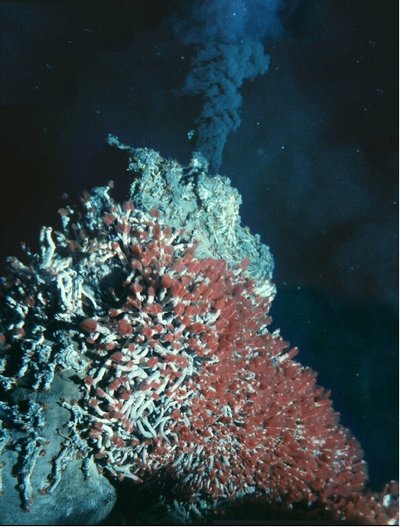September 23, 2005
Public to see live broadcast for first time of surreal seafloor off Washington
UPDATE THURSDAY, SEPT. 29:
Scientists intend to broadcast live from the ship as planned from 2 to 3 p.m. today, Sept. 29, provided the weather doesn’t get so bad that the broadcast signal is disrupted. The storm underway at sea means that images from the seafloor will not be live, instead viewers will see video transmitted from the ship in recent days when it was possible to put the submersible in the water.
Tune in for views from the Endeavour Segment of the ridge, an area that experiences earthquakes and volcanic eruptions from time to time and is dotted with eerie spires and chimneys venting water as hot as 700 F. It is one of the most geologically and biologically active sites in the global network of mid-ocean ridges and represents one of the most extreme environments on Earth, say University of Washington oceanographers John Delaney and Deborah Kelley, who are chief scientists of the VISIONS ’05 expedition Sept. 1 through Oct 4.
Daily updates about the expedition are at http://www.visions05.washington.edu/.
The live broadcasts, sponsored in part by the National Science Foundation, W.M. Keck Foundation, ResearchChannel and UWTV, are weather-dependent because severe storms could prevent the launch of the remotely operated vehicle that carries a powerful underwater camera to the seafloor.
The plan is to have scientists on the UW research vessel Thomas G. Thompson and in a Seattle studio narrate live broadcasts from 2 to 3 p.m. PDT on Sept. 28 and 29. Puget Sound television viewers can see the hour-long broadcasts on UWTV (channel 27 for subscribers of Comcast) and ReserchChannel (channel 9400 for subscribers of Dish Network). Computer users can see live Webcasts by UWTV (at http://www.uwtv.org), ResearchChannel (at http://www.researchchannel.org/visions05) and the National Science Foundation (at http://www.nsf.gov/).
Before and after the hour-long broadcasts with scientists, there will be additional live images from the seafloor from 10 a.m. to 2 p.m. and 3 to 6 p.m. PDT via the ResearchChannel (on Dish Network channel 9400 or Webcast at http://www.researchchannel.org/visions05).
This month’s live broadcasts offer a preview of future transmissions from seafloor observatories, such as NEPTUNE (http://www.neptune.washington.edu/) where scientists intend to wire 150,000 square miles of seafloor off the west coast of Canada and the United States. Arrays of instruments, cameras and robots, interlinked by fiberoptic cables from land, will be used to study a host of subjects such as erupting volcanoes, migrating marine mammals, deep-sea ecological change, encroaching pollution and the generation of tsunamis.
To this end, the transmissions later this month also are the first from the seafloor anywhere in the world to be broadcast live in high-definition video. While the public broadcasts Sept. 28 and 29 are available only in standard-definition — the same quality as regular television — the ResearchChannel and the National Science Foundation are pioneering the broadcast of live high-definition video from the seafloor to selected research groups and sites in six countries capable of handling the high bandwidth Internet data, says Michael Wellings, director of engineering at UWTV.
“This broadcast provides an example of how the excitement of scientific discovery can be shared with a global audience,” Delaney says. “Even two years ago we could not have transmitted high-definition quality imagery via satellite from a ship. VISIONS ’05 is emblematic of the rapid change in technology-based capabilities that are transforming our interactions with ocean space.
“Live high-definition TV from the seafloor will be common in two to three years.”
High-definition TV has 7 to 10 times the clarity of standard definition TV, leading Kelley to say, “This crisp resolution dramatically enhances the scientist’s ability to operate in remote environments. The incredible quality of the video streams will soon allow the public to connect with scientists online as they conduct their scientific experiments in the deep sea.”
This online capability will be a wonderful way to interest people in our oceans, according to Veronique Robigou, a UW oceanographer who heads a NSF program that places K-12 teachers on expeditions.
“People love the higher definition imagery especially for nature shows on TV. It really attracts the attention of the younger generation,” Robigou says. “The more they tun in, the more they can learn.”
The five-week expedition, which is funded in part by the NSF, W.M. Keck Foundation and UW, is using the remotely controlled submersibles JASON II and ABE from the Woods Hole Oceanographic Institution. The expedition referred to as VISION 05, for Visually Integrated Science for Interactive Ocean Networked Systems, is studying how tectonic plate interaction can support exotic and ancient microbial life forms deep within the seafloor.



